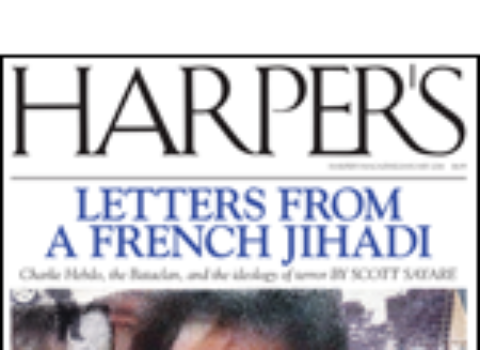Introducing the February Issue
Charles Glass, James Harkin, Eileen Myles, Joseph O'Neill, and more.
When the lunar module for Apollo 17 took off from the moon’s surface, in December 1972, a camera filmed its ascent into space. The camera’s operator, working remotely from Mission Control in Houston, tilted and zoomed out at exactly the right time, capturing ignition, liftoff, and the capsule’s slow-wheeling arc overhead. He did all this while compensating for a three-second delay as the signal traveled 240,000 miles to the moon and back. During the broadcast, he ignored the live feed and synchronized his movements with the countdown, hoping that the module would behave as expected.
There are similar challenges to putting together a magazine like Harper’s. Reporting, editing, and fact-checking a story for publication takes time; to tackle subjects like the Iowa caucuses or the fight against the Islamic State, as we do in our February issue, you have predict what the news will look like days and weeks in the future. You tilt and zoom half blind and hope you get the shot.
Fortunately for us and unfortunately for the republic, the story in Iowa hasn’t changed much as we approach the February 1 caucuses. The conventional wisdom is that it’s something of a scandal that a rural, white, relatively unpopulous state plays such a large role in the American electoral process. In “The Trouble with Iowa,” Richard Manning argues otherwise. Iowa’s prominence, he suggests, is entirely appropriate, since many of the major political conflicts of our time—over climate, immigration, inequality, and corporate power—can be found in their purest form there. With cameos from Ted Cruz, Donald Trump, and Hillary Clinton, and featuring a rousing defense of Chinese ownership of Iowa’s pig farms by Terry Branstad, the state’s governor, Manning delivers the perfect primer for the upcoming vote.
The February issue also contains a three-part look at how the war against the Islamic State is affecting people across the Middle East and Europe. In Iraq, Charles Glass and the photographer Don McCullin embedded with Kurdish and Arab Shiite soldiers. They got an up-close look at the effects of American policy in the region, which Glass calls “at best schizophrenic, at worst criminal.” In Damascus, James Harkin reported on how gay Syrians are surviving the civil war. Harkin spoke at length with Samir, a soldier in Assad’s army, who has chosen to serve a regime that would imprison him in order to fight an insurgency that would execute him. And in Greece, Olivier Kugler interviewed and drew portraits of refugees who had fled the conflict. In his portfolio, we meet Noura, a high-school student who tells Kugler about the destruction her family saw in Aleppo (as well as the cats she had to leave behind); Rezan, a fashion designer whose set of watercolors are among the only objects he has left from home; and Omar, a medical student who says, “I just want to find a safe place and restart my life, study, and build a family.”
This month marks the John Crowley’s final Easy Chair column, and he signs off with a love letter to the Encyclopaedia Britannica. Crowley’s printed set of the E.B. had pride of place in his household: “The books were much loved and much handled, the fore edges of certain volumes darkened where they had been repeatedly opened by grubby fingers.”
Tanya Gold, who savaged Per Se for Harper’s months before Pete Wells did it for the New York Times, returns with a broadside against the British monarchy and all the expensive nonsense that goes along with it. To figure out what makes the Queen so maddening and so fascinating, Gold traveled to each of the monarch’s official residences, hoping to catch a glimpse of the woman she describes as “a two-legged tourist attraction, like St. Paul’s Cathedral but with skin.”
Also in this issue: a new story by Joseph O’Neill, the author of Netherland; Garret Keizer’s flirtation with the Revolutionary Communist Party; four very strange first dates, courtesy of Tinder; and a Star Wars skeptic wonders whether The Force Awakens can make a convert of him.
NASA had tried to film the ascents of the lunar module on two missions before Apollo 17; both attempts failed. The footage from 1972, of what turned out to be the final moon mission, is the only video record of a full lunar liftoff. We aren’t exactly putting men on the moon here, but, when it comes to capturing the decisive moment, I can assure you that this issue is no Apollo 15.




